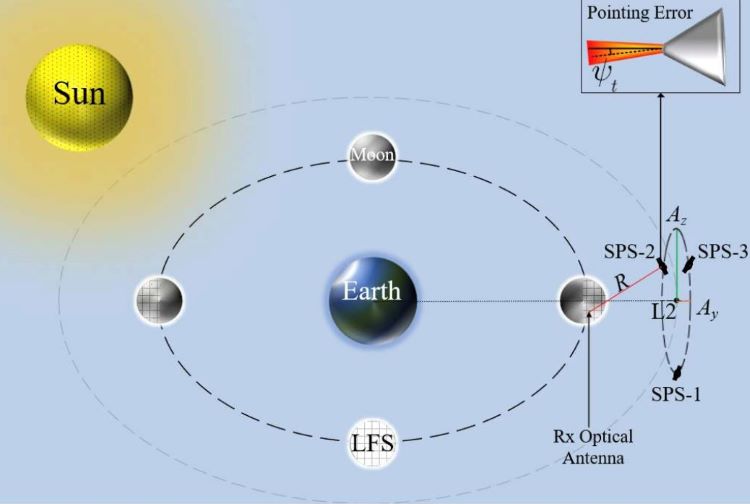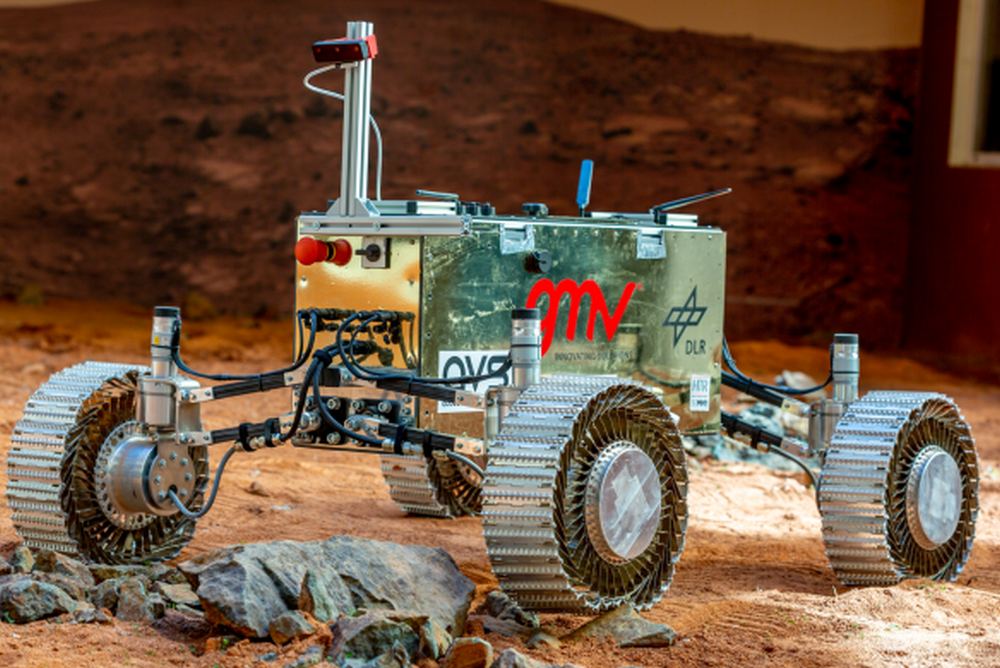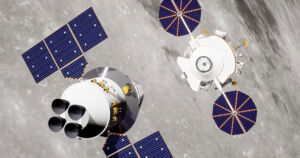Craters are a familiar sight on the lunar surface and indeed on many of the rocky planets in the Solar System. There are other circular features that are picked up on images from orbiters but these pits are thought to be the collapsed roofs of lava tubes. A team of researchers have mapped one of these tubes using radar reflection and created the first 3D map of the tube’s entrance. Places like these could make ideal places to setup research stations, protected from the harsh environment of an alien world.
Continue reading “The Entrance of a Lunar Lava Tube Mapped from Space”Lunar Infrastructure Could Be Protected By Autonomously Building A Rock Wall
Lunar exploration equipment at any future lunar base is in danger from debris blasted toward it by subsequent lunar landers. This danger isn’t just theoretical – Surveyor III was a lander during the Apollo era that was damaged by Apollo 12’s descent rocket and returned to Earth for closer examination. Plenty of ideas have been put forward to limit this risk, and we’ve reported on many of them, from constructing landing pads out of melted regolith to 3D printing a blast shield out of available materials. But a new paper from researchers in Switzerland suggests a much simpler idea – why not just build a blast wall by stacking a bunch of rocks together?
Continue reading “Lunar Infrastructure Could Be Protected By Autonomously Building A Rock Wall”Do Protons Decay? The Answer Might be on the Moon

Does proton decay exist and how do we search for it? This is what a recently submitted study hopes to address as a team of international researchers investigate a concept of using samples from the Moon to search for evidence of proton decay, which remains a hypothetical type of particle decay that has yet to be observed and continues to elude particle physicists. This study holds the potential to help solve one of the longstanding mysteries in all of physics, as it could enable new studies into deep-level and the laws of nature, overall.
Continue reading “Do Protons Decay? The Answer Might be on the Moon”How Much Water Would a Self-Sustaining Moonbase Need?
As humanity returns to the Moon in the next few years, they’re going to need water to survive. While resupplies from Earth would work for a time, eventually the lunar base would have to become self-sustaining? So, how much water would be required to make this happen? This is what a recently submitted study hopes to address as a team of researchers from Baylor University explored water management scenarios for a self-sustaining moonbase, including the appropriate location of the base and how the water would be extracted and treated for safe consumption using appropriate personnel.
Continue reading “How Much Water Would a Self-Sustaining Moonbase Need?”Wireless Power Transmission Could Enable Exploration of the Far Side of the Moon

How can future lunar exploration communicate from the far side of the Moon despite never being inline with the Earth? This is what a recent study submitted to IEEE Transactions on Aerospace and Electronic Systems hopes to address as a pair of researchers from the Polytechnique Montréal investigated the potential for a wireless power transmission method (WPT) comprised of anywhere from one to three satellites located at Earth-Moon Lagrange Point 2 (EMLP-2) and a solar-powered receiver on the far side of the Moon. This study holds the potential to help scientists and future lunar astronauts maintain constant communication between the Earth and Moon since the lunar far side of the Moon is always facing away from Earth from the Moon’s rotation being almost entirely synced with its orbit around the Earth.
Continue reading “Wireless Power Transmission Could Enable Exploration of the Far Side of the Moon”It’s Time to Study Lunar Lava Tubes. Here’s a Mission That Could Help

The Moon is practically begging to be explored, and the momentum to do so is building. The Artemis Program’s effort to return astronauts to the Moon for the first time since the Apollo missions captures a lot of attention. But there are other efforts underway.
Continue reading “It’s Time to Study Lunar Lava Tubes. Here’s a Mission That Could Help”China Names its Capsule and Lander for its Upcoming Human Lunar Missions
In a recent announcement, the Chinese Space Agency (CSA) unveiled the names for its forthcoming lunar mission components. The CSA have been working towards sending humans to the Moon through a series of robotic missions. The 22-tonne capsule that is taking the astronauts to the Moon is called Mengzhuo (translates to ‘dream vessel’) and the lander has been named Lanyue (meaning ‘embracing the Moon’). Assuming all goes to plan, they will send two humans and a rover to the surface of the Moon by 2030.
Continue reading “China Names its Capsule and Lander for its Upcoming Human Lunar Missions”Europe is Working on a Multi-Purpose Habitat for the Moon

With NASA gearing up to send humans back to the Moon in the next few years with the Artemis missions with the goal of establishing a permanent outpost at the lunar south pole, nations are making efforts to contribute to Artemis and a permanent presence on our nearest celestial neighbor. Recently, the Italian Space Agency, formally known as Agenzia Spaziale Italiana (ASI), has taken steps to establish the first permanent outpost on the lunar surface, known simply as the Multi-Purpose Habitat (MPH). This endeavor was officially kicked by the ASI signing a contract with the French-based aerospace company, Thales Alenia Space, who specializes in space-based systems, including ground segments and satellites used for both Earth observation and space exploration.
Continue reading “Europe is Working on a Multi-Purpose Habitat for the Moon”NASA Wants to Learn to Live Off the Land on the Moon

In preparation for the upcoming Artemis missions to the lunar south pole, NASA recently solicited a Request for Information (RFI) from the lunar community to map out its future Lunar Infrastructure Foundational Technologies (LIFT-1) demonstration for developing In-situ Resource Utilization (ISRU) technologies as part of the agency’s ambitious Lunar Surface Innovation Initiative (LSII). The primary goal of LIFT-1, which is being driven by NASA’s Space Technology Mission Directorate (STMD), is to advance ISRU technologies for extracting oxygen from the lunar regolith, including manufacturing, harnessing, and storing the extracted oxygen for use by future astronauts on the lunar surface. Proposals for LIFT-1 became available to be submitted via NSPIRES on November 6, 2023, with a deadline of December 18, 2023.
Continue reading “NASA Wants to Learn to Live Off the Land on the Moon”ESA is Testing a Modular Multipurpose Rover that Could Be a Science Lab or a Tiny Bulldozer

Most rovers have been built for Mars, and each one of them is a complex machine designed with specific goals and terrains in mind. But the Moon is different than Mars. We’re not searching for life there; we’re trying to establish a presence.
In recognition of the difference, the ESA is developing modular rovers that can serve different needs with only small modifications.
Continue reading “ESA is Testing a Modular Multipurpose Rover that Could Be a Science Lab or a Tiny Bulldozer”



